
Overview Who Needs This? Excerpts Order Book Pictures Chapters
Answers Reviews Destinations Free Stuff More Contact Us
Death Valley Camping
Death valley camping and backcountry information. Death Valley Camping is year round (if you can take the heat during the summer but few can or want to) and the weather is generally dry, sunny, and clear throughout the year, think Afghanistan. Peak visitor season is through the winter and spring months. Death Valley has 3.3 million acres of desert wilderness for backcountry camping and over 600 miles of backcountry dirt roads open to camping. It's Americas biggest National park.
You can obtain a free backcountry camping permit at the Furnace Creek Visitor Center or any ranger station along with rules and regulations of backcountry camping in Death Valley. Due to the extreme heat during the long summer, campgrounds in the low elevations close. The Furnace Creek Campground stays open year round. Several higher elevation campgrounds and camping areas in the mountains stay open year round too.
Campgrounds that are open all year are Furnace Creek, Mesquite Spring, Wildrose, and for tent camping only there is the Emigrant campground. Free camping is at Emigrant, Wildrose, Thorndike and Mahogany Flat.
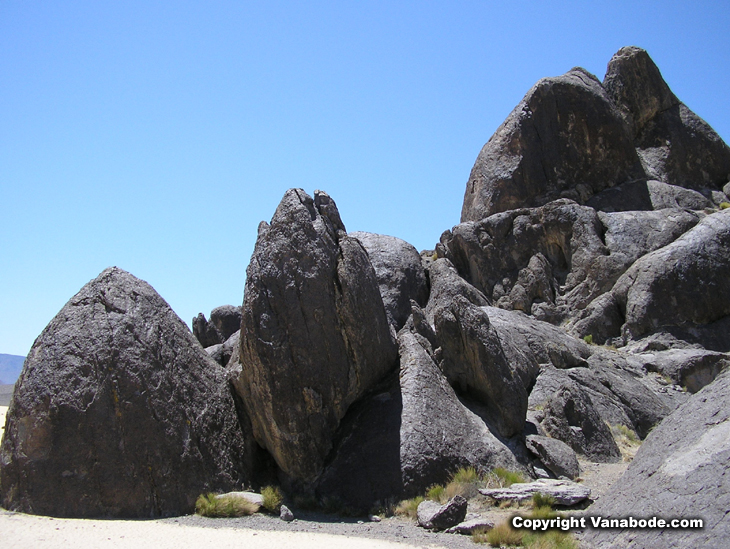
Backcountry dirt road driving is serious business. If you are lucky, we were not, you might come out with your spare tire still in the trunk. You could have steering damage, or the oil pan can get punctured and leak. Not only is a high clearance vehicle or 4-wheel-drive vehicle recommended it is really necessary on all of Death Valley's rough dirt roads if you want to be safe. Getting stranded in the desert without cell phone connection can be deadly. Especially since many roads are traveled by ONE person that day - you.
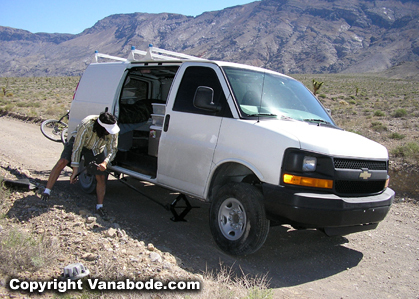
Above: Picture of boulders all jumbled together in the middle of the race track which is a dry lake bed.
Left: Some dirt roads start out with gravel, rock, washboard then quickly disintegrate into nearly nothing and require a 4 x 4 to proceed. Yea that's me changing a tire.
These dirt roads go for 10 miles to 28 miles one way to reach a hike, camping, or geological wonder. Favorite backcountry roads are Echo Canyon, Titus Canyon, The Racetrack, and Butte Valley via Warm Springs Canyon.
Below: Lonely rock picture, see the marking on the dried lake
bed surface where it originated.
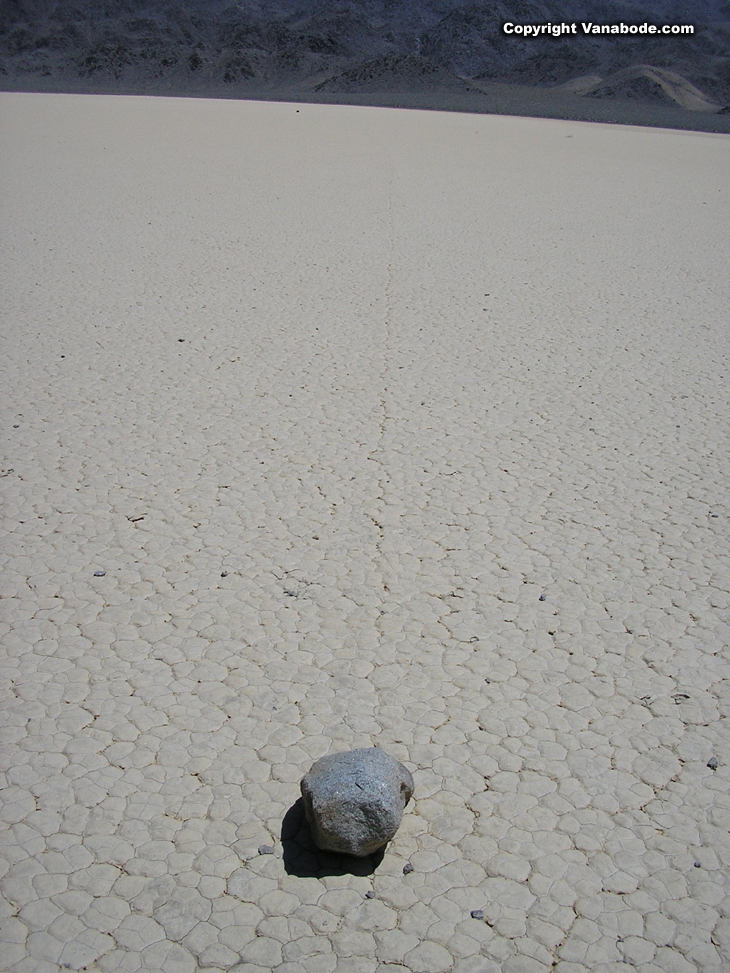
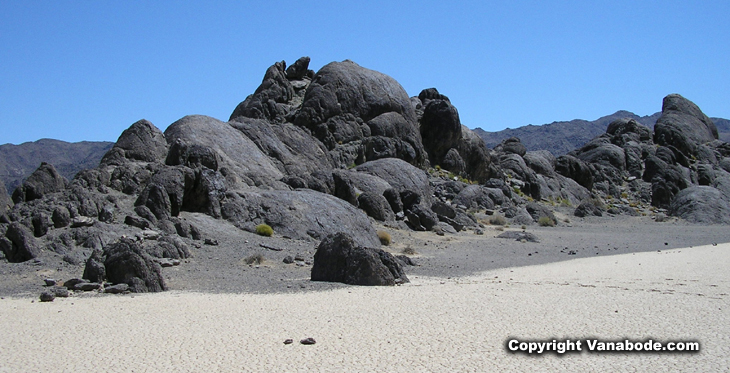
Above: Picture of rocks and boulders on the Race Track.
You can hike 770 feet into Ubehebe Crater via the very steep trail. I'm sure it is fun being down in the middle of this crater that was created by a steam explosion, but the hike climbing back out is grueling. Or you can hike along west rim of Ubehebe Crater to Little Hebe and several other craters on the 1.5 mile loop. The Racetrack Playa is a dried up river bed where rocks mysteriously slide across it and the black boulders in the middle of the lake even puzzle geologists. But what a beautiful contrast they make. We climbed all over these rocks and had a great time. We had to, we just drove 27 hellacious miles to get there. We were lucky we only got one flat tire. Someone told us that the day before a ranger got three flat tires driving to The Racetrack. We saw a coyote on the road while driving to Scotty's Castle. We pulled over and the coyote just kept circling around the van as if we were going to give it a slice of bologna or something. While camping at Mesquite Springs we heard a few coyotes and saw some Jack Rabbits in the evening.
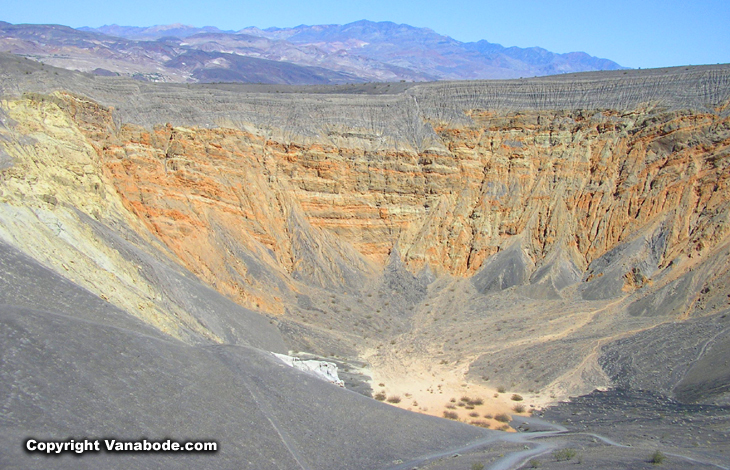
Above: Picture of Ubehebe (pronounced You-Be-Be) Crater.
Well-maintained air-conditioned vehicles usually do not have trouble with traveling in and through Death Valley National Park, but because of summer temperatures vacations to the park require extra planning and extra care of your vehicle. In several locations throughout the park there are radiator water services. Most vehicle rental agreements restrict vehicles to paved roads. Be aware that the car rental company can charge you for damage to the vehicle outside of the contract agreement specifications. Towing insurance and AAA may not be valid on backcountry dirt roads. Typical towing charges for remote areas within Death Valley National Park range from $250 to $1000 dollars or more.
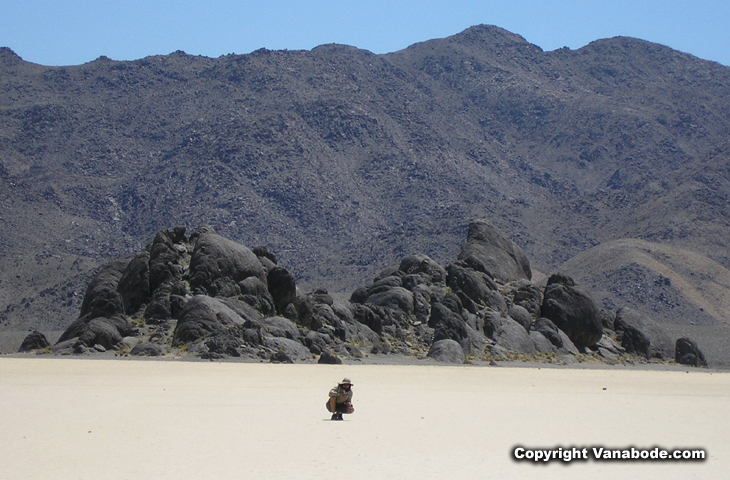
Above: Picture of Jason on the Race Track lake bed. If you do attempt to travel on any of the dirt roads make sure you have at least one good full-size spare tire and all the tools and equipment needed to change a flat. Most rental sedans have a small spare tire (donut) and should be driven only on paved roads and short maintained dirt roads. Most rental 4WD and all-wheel-drive SUV’s are equipped with standard street tires rather than truck tires. On high clearance 2WD and rougher 4WD roads these tires are more susceptible to tire puncture and multiple flat tires.
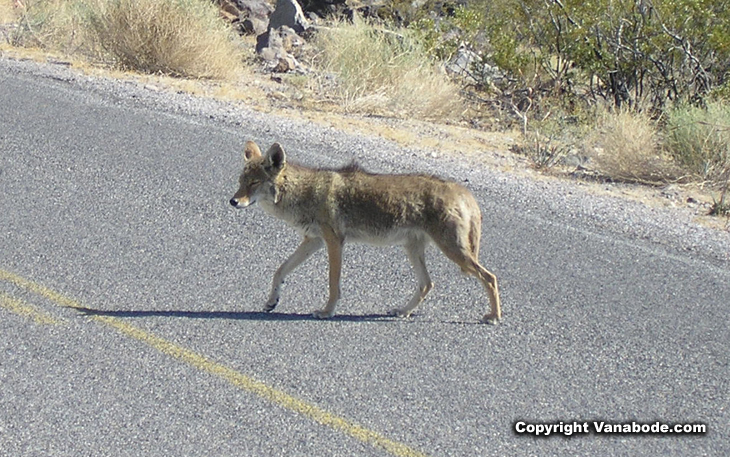
Above: Picture of coyote that was walking down the road. When we stopped he just hung around.
Jason's thoughts - The sliding rocks were FREAKY and so interesting. This land is so perfectly flat and so dry the surface becomes a sort of heated slide and the strong winds actually push the rocks around on the dry bed. See the pictures on this page and also this Death Valley sliding rock picture. When deciding to actually drive say 5-12 miles ONE WAY on an incredibly rocky and tough offroad dirt road REMEMBER you will only be moving about 5-10 miles an hour IF you don't break down. We went 27 miles ONE WAY to see the RaceTrack and it took over 3 hours of arduous, tire splitting, back twisting, neck twisting, dusty driving. We were actually sore for about 4 days after the trip was over due to all the roughness. Fun though because we don't take our van offroad too much. It was also super nice because when we got to the RaceTrack NOBODY was there the entire time we were there. Very romantic and almost surreal.
Kelly's thoughts - Unless you plan to visit Scotty's Castle in the northern part of Death Valley and maybe The Racetrack, I personally would not make the trip to see Ubehebe Crater. On second thought, maybe I should've spent more time hiking the crater loop. What a wild ride on the long 27 mile washboard, rock, gravel, dirt road of Racetrack Road. When we got to The Racetrack we were the only ones there for hours. And, of course, I am the one that got us into this mess. I wish I had gotten a picture of us at Teakettle Junction.
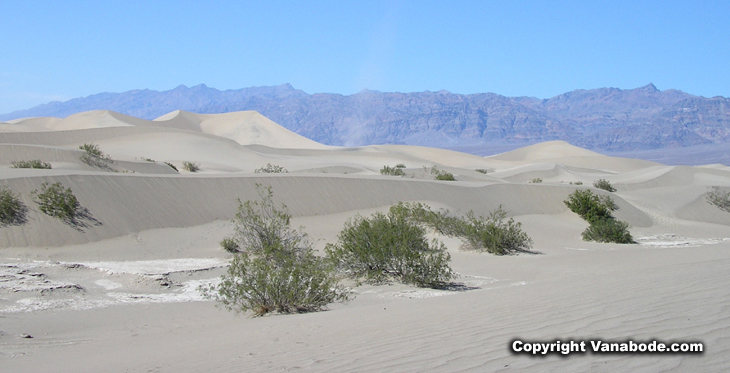
Above: Picture of sand dunes in Death Valley. Travel Info - There are very few fuel stops in Death Valley and it sells for twice the normal rate elsewhere; some locations close without warning. Fill up outside the park. Death Valley National Park is located in southeastern California with a little part of it in southwestern Nevada.
Visit RV Camping for more information on RV parks in and outside of Death Valley. More information on the Sand Dunes, Zabriskie Point, and Salt Creek. Click More on the wildflowers of Death Valley. More on the Golden Canyon Gower Gulch Loop and Scotty's Castle.
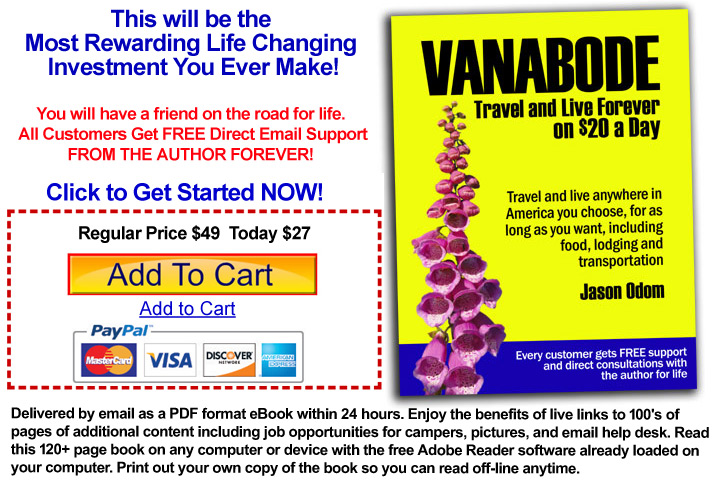

Home
Contact Us Copyright
© 2007-2016 Free
Guide They Hate Me
Privacy
Policy Terms
and Conditions Media
Press Affiliate